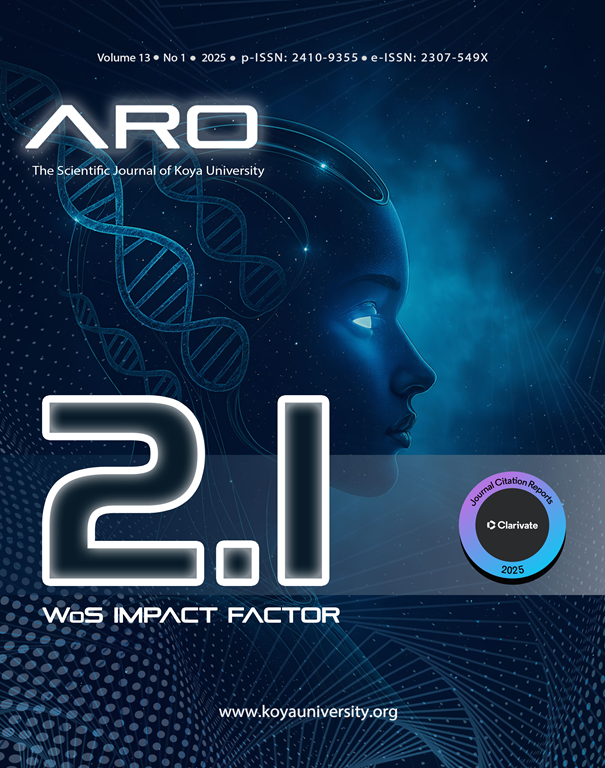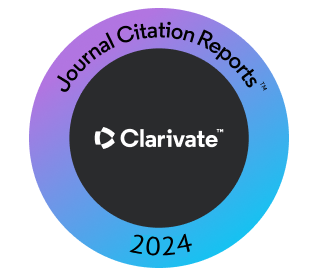A Novel Skin Cancer Detection Approach Using Deep Learning Algorithm with Image Segmentation Filters
DOI:
https://doi.org/10.14500/aro.12024Keywords:
Computer vision, Deep learning, Edge, Neural Network, Skin cancer, ThresholdAbstract
Skin cancer is considered one of the most common and dangerous diseases in the world because so many people do not pay attention to it. In addition, skin cancer is a medical condition that a doctor cannot accurately diagnose from imaging data during a manual examination. Therefore, there is a great need to apply deep learning methods for early detection of skin cancer, as these methods are excellent in the field of medical image processing. This paper presents a deep learning model based on the convolutional neural network algorithm to provide automatic detection of skin cancer. The model basically consists of two scenarios: binary classification (benign and malignant) of the data set without an image segmentation process and binary classification of the same data set after applying four image segmentation methods (threshold-based segmentation, edge-based segmentation, binary fill holes technique, and removing small objects). The input images in the first scenario are three channels and one channel in the second scenario. These image segmentation techniques have significantly improved the accuracy of the proposed model, as the proposed model achieved 92.18% before applying segmentation and 96.83% after applying image segmentation.
Downloads
References
Abdulrahman, A., and Varol, S., 2020. A review of image segmentation using MATLAB environment. In: 2020 8th International Symposium on Digital Forensics and Security (ISDFS). IEEE, pp.1-5. DOI: https://doi.org/10.1109/ISDFS49300.2020.9116191
Adegun, A.A., and Viriri, S., 2019. Deep learning-based system for automatic melanoma detection. IEEE Access, 8, pp.7160-7172. DOI: https://doi.org/10.1109/ACCESS.2019.2962812
Al-Amri, S.S., and Kalyankar, N.V., 2010. Image Segmentation by using Threshold Techniques. [Preprint].
Baykara, M., and Abdulrahman, A., (2022) A novel approach for emotion recognition based on eeg signal using deep learning. Applied Sciences, 12, p.10028. DOI: https://doi.org/10.3390/app121910028
Baykara, M., and Abdulrahman, A., 2021. Seizure detection based on adaptive feature extraction by applying extreme learning machines. Traitement du Signal, 38(2), pp.331-340. DOI: https://doi.org/10.18280/ts.380210
Canny, J., 1986. Acomputational approach to edge detection. IEEE Transactions on Pattern Analysis and Machine Intelligence, PAMI-8(6), pp.679-698. DOI: https://doi.org/10.1109/TPAMI.1986.4767851
Codella, N.C., Nguyen, Q.B., Pankanti, S., Gutman, D.A., Helba, B., Halpern, A.C., and Smith, J.R., 2017. Deep learning ensembles for melanoma recognition in dermoscopy images. IBM Journal of Research and Development, 61(4/5), pp.5-1. DOI: https://doi.org/10.1147/JRD.2017.2708299
Deriche, R., 1987. Optimal edge detection using recursive filtering. International Journal of Computer Vision, 2, pp.167-187. DOI: https://doi.org/10.1007/BF00123164
Ech-Cherif, A., Misbhauddin, M., and Ech-Cherif, M., 2019. Deep neural network based mobile dermoscopy application for triaging skin cancer detection. In: 2019 2nd International Conference on Computer Applications and Information Security (ICCAIS). IEEE, pp.1-6. DOI: https://doi.org/10.1109/CAIS.2019.8769517
Gouda, W., Sama, N.U., Al-Waakid, G., Humayun, M., and Jhanjhi, N.Z., 2022. Detection of skin cancer based on skin lesion images using deep learning. In: Healthcare. Vol. 10. MDPI, Switzerland, p.1183. DOI: https://doi.org/10.3390/healthcare10071183
Guan, Q., Wang, Y., Ping, B., Li, D., Du, J., Qin, Y., Lu, H., Wan, X., and Xiang, J., 2019. Deep convolutional neural network VGG-16 model for differential diagnosing of papillary thyroid carcinomas in cytological images: A pilot study. Journal of Cancer, 10(20), p.4876. DOI: https://doi.org/10.7150/jca.28769
Hong, R., Park, J., Jang, S., Shin, H., Kim, H., and Song, I., 2021. Development of a parcel-level land boundary extraction algorithm for aerial imagery of regularly arranged agricultural areas. Remote Sensing, 13(6), p.1167. DOI: https://doi.org/10.3390/rs13061167
Hosny, K.M., Kassem, M.A., and Foaud, M.M., 2018. Skin Cancer Classification using Deep Learning and Transfer Learning. In 2018 9th Cairo International Biomedical Engineering Conference (CIBEC). IEEE, pp.90-93. DOI: https://doi.org/10.1109/CIBEC.2018.8641762
Kandhro, I.A., Manickam, S., Fatima, K., Uddin, M., Malik, U., Naz, A., and Dandoush, A., 2024. Performance evaluation of E-VGG19 model: Enhancing real-time skin cancer detection and classification. Heliyon, 10(10), p.10028. DOI: https://doi.org/10.1016/j.heliyon.2024.e31488
Ma, W.Y., and Manjunath, B.S., 2000. EdgeFlow: A technique for boundary detection and image segmentation. IEEE Transactions on Image Processing, 9(8), pp.1375-1388. DOI: https://doi.org/10.1109/83.855433
Nawaz, M., Mehmood, Z., Nazir, T., Naqvi, R.A., Rehman, A., Iqbal, M., and Saba, T., 2022. Skin cancer detection from dermoscopic images using deep learning and fuzzy k‐means clustering. Microscopy Research and Technique, 85(1), pp.339-351. DOI: https://doi.org/10.1002/jemt.23908
Ozdemir, B., and Pacal, I., 2025. An innovative deep learning framework for skin cancer detection employing ConvNeXtV2 and focal self-attention mechanisms. Results in Engineering, 25, p.103692. DOI: https://doi.org/10.1016/j.rineng.2024.103692
Rahi, M.M.I., Khan, F.T., Mahtab, M.T., Ullah, A.A., Alam, M.G.R., and Alam, M.A., 2019 Detection of skin cancer using deep neural networks. In 2019 IEEE Asia-Pacific Conference on Computer Science and Data Engineering (CSDE). IEEE, pp.1-7. DOI: https://doi.org/10.1109/CSDE48274.2019.9162400
Ramadhan, A.A., and Baykara, M., 2022. Anovel approach to detect COVID-19: Enhanced deep learning models with convolutional neural networks. Applied Sciences, 12(18), p.9325. DOI: https://doi.org/10.3390/app12189325
Reis, H.C., Turk, V., Khoshelham, K., and Kaya, S., 2022. InSiNet: A deep convolutional approach to skin cancer detection and segmentation. Medical and Biological Engineering and Computing, 60, pp.643-662. DOI: https://doi.org/10.1007/s11517-021-02473-0
Schaefer, G., Krawczyk, B., Celebi, M.E. and Iyatomi, H., 2013. Melanoma classification using dermoscopy imaging and ensemble learning. In: 2013 2nd IAPR Asian Conference on Pattern Recognition. IEEE, pp.386-390. DOI: https://doi.org/10.1109/ACPR.2013.102
Somasundaram, K., and Kalaiselvi, T., 2010, February. A method for filling holes in objects of medical images using region labeling and run length encoding schemes. In: National Conference on Image Processing (NCIMP), pp.110-115.
Swapno, S.M.R., Nobel, S.N., Meena, P.K., Meena, V.P., Bahadur, J., and Appaji, A., 2025. Accelerated and precise skin cancer detection through an enhanced machine learning pipeline for improved diagnostic accuracy. Results in Engineering, 25, p.104168. DOI: https://doi.org/10.1016/j.rineng.2025.104168
Tan, T.Y., Zhang, L., and Lim, C.P., 2019. Intelligent skin cancer diagnosis using improved particle swarm optimization and deep learning models. Applied Soft Computing, 84, p.105725. DOI: https://doi.org/10.1016/j.asoc.2019.105725
Yang, Y., Zang, B., Song, C., Li, B., Lang, Y., Zhang, W., and Huo, P., 2024. Small object detection in remote sensing images based on redundant feature removal and progressive regression. IEEE Transactions on Geoscience and Remote Sensing, 62, p.3417960 DOI: https://doi.org/10.1109/TGRS.2024.3417960
Downloads
Published
How to Cite
Issue
Section
License
Copyright (c) 2025 Awf A. Ramadhan, Omer S. Kareem, Diyar Q. Zeebaree

This work is licensed under a Creative Commons Attribution-NonCommercial-ShareAlike 4.0 International License.
Authors who choose to publish their work with Aro agree to the following terms:
-
Authors retain the copyright to their work and grant the journal the right of first publication. The work is simultaneously licensed under a Creative Commons Attribution License [CC BY-NC-SA 4.0]. This license allows others to share the work with an acknowledgement of the work's authorship and initial publication in this journal.
-
Authors have the freedom to enter into separate agreements for the non-exclusive distribution of the journal's published version of the work. This includes options such as posting it to an institutional repository or publishing it in a book, as long as proper acknowledgement is given to its initial publication in this journal.
-
Authors are encouraged to share and post their work online, including in institutional repositories or on their personal websites, both prior to and during the submission process. This practice can lead to productive exchanges and increase the visibility and citation of the published work.
By agreeing to these terms, authors acknowledge the importance of open access and the benefits it brings to the scholarly community.
Accepted 2025-04-07
Published 2025-04-28
















 ARO Journal is a scientific, peer-reviewed, periodical, and diamond OAJ that has no APC or ASC.
ARO Journal is a scientific, peer-reviewed, periodical, and diamond OAJ that has no APC or ASC.